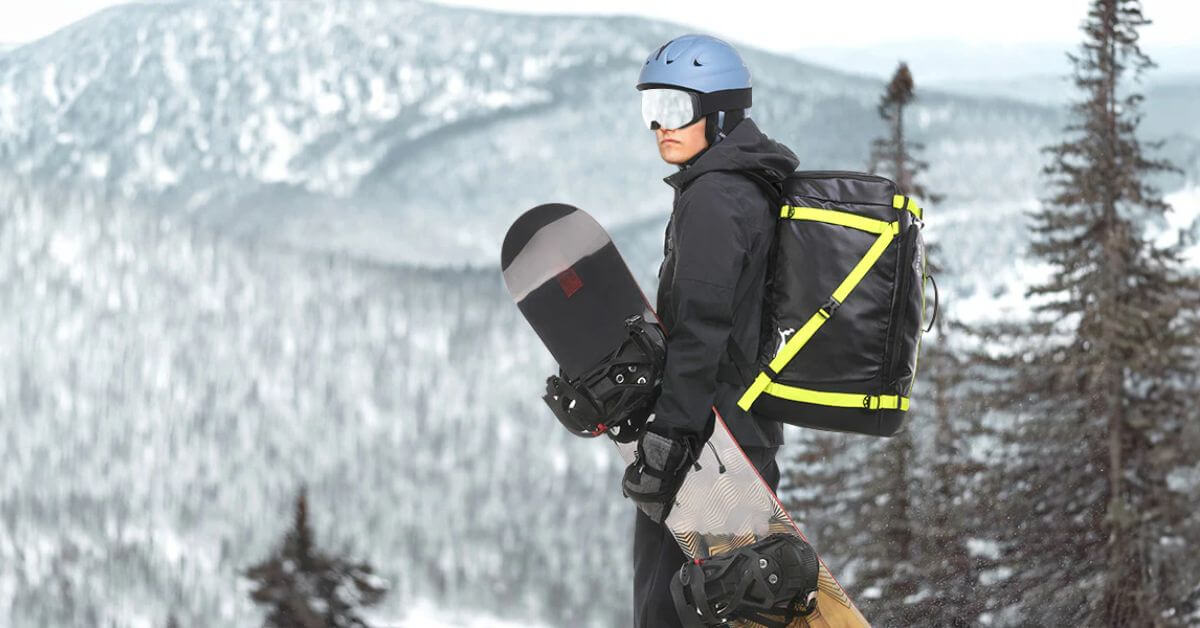Skiing with a backpack might sound simple, but it’s more than just strapping on gear and hitting the slopes. Whether you’re tackling backcountry terrain or heading up resort trails, having the right pack can make or break your experience.
It’s not just about carrying snacks and sunscreen, it’s about balance, safety, and smart organisation. In the mountains, conditions can change fast. That’s why skiing with a backpack requires thoughtful preparation. The wrong setup can throw off your centre of gravity or wear you down with bulk and discomfort.
On the flip side, the right one supports your body, stores all essentials, and helps you stay agile no matter how demanding the trail becomes. Today’s skiers are smarter and better equipped than ever.
They understand that skiing with a backpack means more than utility, it’s also about performance, movement, and planning. From emergency gear to hydration, every item matters. Let’s break down what to look for in a ski-ready backpack and the top 10 packing tips to help you glide smoothly from lift to slope.
Must-Have Features for Skiing With a Backpack
1. Lightweight Yet Durable Material
Choose ripstop nylon or high-denier polyester for the perfect mix of weight and strength. These materials resist tears and snow moisture while staying light enough for all-day skiing. A lighter pack means better agility, less fatigue, and more fun on the slopes.
2. Ergonomic Fit and Padded Back Panel
An ergonomic design with padded shoulder straps and a breathable back panel ensures comfort all day long. It reduces pressure points and lets your back stay dry. A well-fitted backpack moves with your body, not against it, making skiing with a backpack smooth and natural.
3. Chest and Waist Straps for Stability
Chest and waist straps prevent your backpack from shifting while turning, jumping, or stopping quickly. They stabilise your load and distribute weight evenly. This is essential when skiing with a backpack, helping you maintain balance and control on dynamic terrain.
4. Avalanche Gear Compartment
If you're heading into the backcountry, a specific pocket for avalanche tools is a must. It keeps shovels, probes, and other lifesaving gear organised and instantly accessible. In emergencies, every second counts this feature can truly save lives.
5. Insulated Hydration Sleeve
Staying hydrated is vital, especially at high altitudes. An insulated hydration sleeve prevents your tube from freezing and keeps water accessible. This feature keeps your hydration system working in freezing conditions and saves time on the trail.
6. External Helmet Carry System
A helmet carry system gives you somewhere secure to attach your helmet when not in use. It frees up space inside your backpack and keeps your gear organised. Whether climbing or resting, it’s a simple but essential convenience for any skier.
7. Ski or Snowboard Carry Straps
These allow you to carry your skis or board when the terrain requires walking or climbing. Whether vertical or diagonal, carry straps keep your hands free and your gear tightly secured making travel across flats or steep terrain more efficient.
8. Fleece-Lined Goggle Pocket
Protect your goggles from scratches and fog with a fleece-lined, dedicated pocket. It keeps lenses clear and safe, away from hard or abrasive gear. For anyone skiing with a backpack, clean goggles mean clear vision and a safer ride.
9. Glove-Friendly Zippers and Clips
Avoid fumbling in freezing temperatures. Oversized zippers and clips are easy to use even with gloves on, letting you grab gear without exposing your fingers to the cold. It’s a small feature that adds major convenience and safety on the slopes.
10. Reflective Details and Whistle Buckle
Visibility is crucial in snowy, low-light conditions. Reflective strips help others see you, while a whistle built into the chest strap can signal for help in emergencies. It’s a simple addition that adds security when skiing in remote or backcountry areas.
Key Backpack Features vs Benefits
| Feature | Why It Matters | Benefit on the Slopes |
|---|---|---|
| Lightweight Material | Reduces fatigue | More agility and longer skiing time |
| Chest & Waist Straps | Keeps pack stable | Maintains balance and posture |
| Avalanche Gear Pockets | Fast access in emergencies | Potentially life-saving in off-piste conditions |
| Hydration Sleeve | Prevents frozen lines | Keeps you hydrated without stopping |
| Helmet Carry | Saves internal space | Keeps helmet safe during climbs or breaks |
| Goggle Pocket | Scratch-free storage | Clear vision maintained |
| Ski/Snowboard Carry Straps | Transport gear hands-free | Easier uphill movement |
| Reflective Details/Whistle | Boosts visibility and emergency readiness | Enhances safety during low visibility |
10 Essential Packing Tips for Skiing With a Backpack
1. Prioritise Essentials
Start with the basics: avalanche gear, high-energy snacks, hydration packs, and a compact first-aid kit. These are your core survival and performance tools when skiing with a backpack. Pack them first so they’re easy to access and ensure you never hit the slopes underprepared.
2. Distribute Weight Evenly
Proper weight distribution is key when skiing with a backpack. Pack heavier items close to your back and centred to maintain balance, reduce strain, and avoid unnecessary wobble. A stable centre of gravity keeps you agile and helps prevent back fatigue on long runs.
3. Use Compression Straps
Secure your gear tightly using external compression straps. These help compact your load, prevent contents from shifting, and improve your aerodynamics. When skiing with a backpack, a stable and compressed pack will keep you steady on uneven terrain and during fast descents.
4. Keep Frequently Used Items Accessible
Don’t bury items you’ll need on the go. Keep things like snacks, lip balm, gloves, or your phone in top or side pockets. Quick access makes a big difference, especially in cold weather. Efficient packing equals smoother skiing with a backpack all day.
5. Roll, Don’t Fold
Rolling your clothing or gear items saves space and prevents bulky shapes. It also reduces wrinkles and helps keep your backpack organised. When skiing with a backpack, space efficiency is everything, you’ll thank yourself for the extra room and easier repacking.
6. Waterproof All Contents
Snow and moisture can sneak in, so line your bag with a dry sack or individual waterproof pouches. Protect clothing, tech, and food from dampness. For skiing with a backpack, this step is essential to keep gear safe, dry, and usable in unpredictable weather.
7. Mind the Weather
Always pack for sudden changes. Include a compact windproof shell or insulating mid-layer depending on forecasts. Skiing with a backpack means staying ready for rapid drops in temperature or gusty conditions. Layer smart to stay warm without extra weight.
8. Avoid Overpacking
Less is more. Only bring what you’ll actually use no extras “just in case.” Overloading your backpack throws off balance, causes fatigue, and affects performance. Skiing with a backpack should be efficient, light, and tailored to your day’s terrain and timing.
9. Label Emergency Gear
Clearly mark your first-aid kit, beacon, or GPS with labels or colour-coded pouches. In urgent situations, you’ll find them faster and so can others. This small step is a big part of safety when skiing with a backpack, especially in remote or off-piste areas.
10. Do a Pre-Ski Check
Before setting off, do a full pack check. Are your zips secure? Is the weight distributed properly? Are your straps snug? A 60-second review can prevent bigger issues later. Skiing with a backpack is smoother when you’ve tested your setup before hitting the snow.
Skiing With a Backpack
| Serial Number | Tip | Summary |
|---|---|---|
| 1 | Prioritise Essentials | Pack avalanche gear, snacks, water, first-aid. |
| 2 | Distribute Weight | Keep heavy items close to your back for balance. |
| 3 | Use Compression Straps | Tighten gear to prevent shifting while skiing. |
| 4 | Keep Items Accessible | Store snacks and tools in easy-to-reach pockets. |
| 5 | Roll, Don’t Fold | Roll clothes to save space and keep things tidy. |
| 6 | Waterproof Contents | Use dry bags to protect gear from snow and moisture. |
| 7 | Pack for Weather | Bring layers suited to forecast changes. |
| 8 | Avoid Overpacking | Only carry what you’ll realistically use. |
| 9 | Label Emergency Gear | Clearly mark first-aid and safety equipment. |
| 10 | Do a Pre-Ski Check | Inspect zips, straps, and weight before skiing. |
Final Words
Skiing with a backpack is all about smart choices and proper preparation. Whether you're out for a quick morning run or tackling a full-day backcountry adventure, the right backpack should support, not slow down your performance.
It needs to fit well, feel light, and hold your essentials securely. Every feature should add value, from comfort to safety. When you pack intentionally and keep weight balanced, you stay agile, energised, and ready for anything the mountain throws your way.
A good backpack doesn’t just carry gear it enhances your ride. With the right setup, skiing with a backpack becomes effortless, helping you go further, climb higher, and ski with more confidence.
Also Read: Camping Outfits Summer: Look Cool While Staying Wild
FAQs
What type of backpack is best for skiing?
When skiing with a backpack, choose one made from lightweight, durable materials like ripstop nylon, with padded straps, chest and waist belts, and weather-resistant zippers for comfort and stability on the slopes.
How do I pack properly for skiing with a backpack?
Prioritise essentials like avalanche gear, water, and a first-aid kit. Distribute weight close to your back, roll clothing to save space, and use waterproof liners to protect contents from snow and moisture.
Is skiing with a backpack safe?
Yes, as long as you pack smart and use a backpack with chest and waist straps for stability. Avoid overpacking, check weight distribution, and ensure the pack fits snugly to avoid balance issues.
What safety gear should I include when skiing with a backpack?
Always carry a first-aid kit, avalanche probe, shovel, emergency blanket, and whistle. If going off-piste, a GPS beacon and clearly labelled emergency gear are also essential for safety.
Can I carry my skis or snowboard on my backpack?
Yes. Many ski backpacks include vertical or diagonal carry straps that let you attach skis or a snowboard securely, making it easier to hike across flat or steep terrain when not riding.
How do I stay hydrated while skiing with a backpack?
Use a hydration pack with an insulated sleeve to keep the tube from freezing. Staying hydrated improves performance and reduces fatigue, especially during long sessions in high altitudes.







